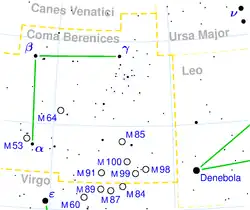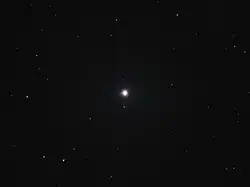Beta Comae Berenices
 Location of β Coma Bernices (upper left) | |
| Observation data Epoch J2000 Equinox J2000 | |
|---|---|
| Constellation | Coma Berenices |
| Right ascension | 13h 11m 52.39383s[1] |
| Declination | +27° 52′ 41.4623″[1] |
| Apparent magnitude (V) | 4.26[2] |
| Characteristics | |
| Spectral type | G0 V[3] |
| U−B color index | +0.08[2] |
| B−V color index | +0.58[4] |
| Astrometry | |
| Radial velocity (Rv) | +5.30±0.13[1] km/s |
| Proper motion (μ) | RA: -800.720 mas/yr[1] Dec.: +882.301 mas/yr[1] |
| Parallax (π) | 108.7250±0.1645 mas[1] |
| Distance | 30.00 ± 0.05 ly (9.20 ± 0.01 pc) |
| Absolute magnitude (MV) | 4.46[5] |
| Details | |
| Mass | 1.15[6] M☉ |
| Radius | 1.14±0.02[7] R☉ |
| Luminosity | 1.357±0.014[8] L☉ |
| Habitable zone inner limit | 0.918[9] au |
| Habitable zone outer limit | 1.96[9] au |
| Surface gravity (log g) | 4.38[4] cgs |
| Temperature | 5,936±33[8] K |
| Metallicity [Fe/H] | +0.07[4] dex |
| Rotation | 12.3±1.1[10] days |
| Rotational velocity (v sin i) | 4.10 ± 0.06[11] km/s |
| Age | 1.5–2.5[12] Gyr |
| Other designations | |
| β Com, 43 Com, BD+28°2193, FK5 492, GJ 502, HD 114710, HIP 64394, HR 4983, SAO 82706, LHS 348, LTT 13815[13] | |
| Database references | |
| SIMBAD | data |
Beta Comae Berenices (β Comae Berenices, β Com) is a solar-type star in the northern constellation of Coma Berenices. It is located at a distance of 30 light-years (9.2 parsecs) from Earth. The Greek letter beta (β) usually indicates that the star has the second highest visual magnitude in the constellation. However, with an apparent visual magnitude of 4.3,[2] this star is actually slightly brighter than α Comae Berenices. It can be seen with the naked eye, but may be too dim to be viewed from a built-up urban area.
Nomenclature

β Comae Berenices (Latinised to Beta Comae Berenices) is the star's Bayer designation, which is abbreviated Beta Com or β Com. The designation was assigned by Francis Baily in 1845.[14] It also has the Flamsteed designation 43 Comae Berenices.[13]
In Chinese astronomy, this star, 37 Com and 41 Com form the asterism Zhōudǐng (周鼎).[14] The Chinese name for β Com itself is Zhōudǐngyī (周鼎一), the first star of Zhōudǐng.[15] In R. H. Allen's Star Names, this name was transliterated as Chow Ting, but the constellation's "lucida" (brightest star, i.e. β Com) was said to be Hing Chin.[16]
Characteristics
The star has a stellar classification of G0 V,[3] compared to G2 V for the Sun. It has a mass of 1.15 solar masses[6] and a radius of 1.14 solar radii.[7] The effective temperature of the outer envelope is 5,936 K,[8] giving it a yellow hue of a G-type star.[17] In terms of age it is younger than the Sun, being about 2 billion years old.[12]
Observations of short term variations in the chromatic activity suggest that the star undergoes differential rotation,[18] with a rotation period of about 11–13 days.[11] Its surface has a measured activity cycle of 16.6 years, compared to 11 years on the Sun. It may also have a secondary activity cycle of 9.6 years.[19] At one time it was thought that this star might have a spectroscopic companion. However, this was ruled out by means of more accurate radial velocity measurements. No planets have yet been detected around it, and there is no evidence of a dusty disk.
The habitable zone for this star, defined as the locations where liquid water could be present on an Earth-like planet, is 0.918–1.96 AU, where 1 AU is the average distance from the Earth to the Sun.[9]
See also
- List of star systems within 25–30 light-years
- Beta Canum Venaticorum, a nearby similar star.
References
- ^ a b c d e Vallenari, A.; et al. (Gaia collaboration) (2023). "Gaia Data Release 3. Summary of the content and survey properties". Astronomy and Astrophysics. 674: A1. arXiv:2208.00211. Bibcode:2023A&A...674A...1G. doi:10.1051/0004-6361/202243940. S2CID 244398875. Gaia DR3 record for this source at VizieR.
- ^ a b c Johnson, H. L.; et al. (1966), "UBVRIJKL photometry of the bright stars", Communications of the Lunar and Planetary Laboratory, 4 (99): 99, Bibcode:1966CoLPL...4...99J
- ^ a b Gray, R. O.; Napier, M. G.; Winkler, L. I. (April 2001), "The Physical Basis of Luminosity Classification in the Late A-, F-, and Early G-Type Stars. I. Precise Spectral Types for 372 Stars", The Astronomical Journal, 121 (4): 2148–2158, Bibcode:2001AJ....121.2148G, doi:10.1086/319956
- ^ a b c Mallik, Sushma V. (October 1998), "Chromospheric activity in cool stars and the lithium abundance", Astronomy and Astrophysics, 338: 623–636, Bibcode:1998A&A...338..623M
- ^ Holmberg, J.; et al. (July 2009), "The Geneva-Copenhagen survey of the solar neighbourhood. III. Improved distances, ages, and kinematics", Astronomy and Astrophysics, 501 (3): 941–947, arXiv:0811.3982, Bibcode:2009A&A...501..941H, doi:10.1051/0004-6361/200811191, S2CID 118577511
- ^ a b Takeda, G.; et al. (2007), "Stellar parameters of nearby cool stars. II. Physical properties of ~1000 cool stars from the SPOCS catalog", Astrophysical Journal Supplement Series, 168 (2): 297–318, arXiv:astro-ph/0607235, Bibcode:2007ApJS..168..297T, doi:10.1086/509763, S2CID 18775378 Note: see VizieR catalogue J/ApJS/168/297.
- ^ a b Baines, Ellyn K.; Clark, James H.; Kingsley, Bradley I.; Schmitt, Henrique R.; Stone, Jordan M. (2025-05-07), "Vintage NPOI: New and Updated Angular Diameters for 145 Stars", The Astronomical Journal, 169 (6): 293, arXiv:2506.02912, Bibcode:2025AJ....169..293B, doi:10.3847/1538-3881/adc930, ISSN 1538-3881
- ^ a b c Boyajian, Tabetha S.; et al. (February 2012), "Stellar Diameters and Temperatures. I. Main-sequence A, F, and G Stars", The Astrophysical Journal, 746 (1): 101, arXiv:1112.3316, Bibcode:2012ApJ...746..101B, doi:10.1088/0004-637X/746/1/101, S2CID 18993744. See Table 10.
- ^ a b c Cantrell, Justin R.; et al. (October 2013), "The Solar Neighborhood XXIX: The Habitable Real Estate of Our Nearest Stellar Neighbors", The Astronomical Journal, 146 (4): 99, arXiv:1307.7038, Bibcode:2013AJ....146...99C, doi:10.1088/0004-6256/146/4/99, S2CID 44208180
- ^ Brandenburg, Axel; et al. (August 2017), "Evolution of Co-existing Long and Short Period Stellar Activity Cycles", The Astrophysical Journal, 845 (1): 79, arXiv:1704.09009, Bibcode:2017ApJ...845...79B, doi:10.3847/1538-4357/aa7cfa
- ^ a b Gray, David F.; Baliunas, Sallie L. (January 1997), "The Rotation of the G0 Dwarf beta Comae", Astrophysical Journal, 475 (1): 303–312, Bibcode:1997ApJ...475..303G, doi:10.1086/303522
- ^ a b Mamajek, Eric E.; Hillenbrand, Lynne A. (November 2008), "Improved Age Estimation for Solar-Type Dwarfs Using Activity-Rotation Diagnostics", The Astrophysical Journal, 687 (2): 1264–1293, arXiv:0807.1686, Bibcode:2008ApJ...687.1264M, doi:10.1086/591785, S2CID 27151456
- ^ a b "bet Com". SIMBAD. Centre de données astronomiques de Strasbourg. Retrieved 2025-08-01.
- ^ a b Ridpath, Ian. "Star Tales - Coma Berenices". Retrieved 1 August 2025.
- ^ "AEEA 天文教育資訊網" [Activities of Exhibition and Education in Astronomy] (in Chinese). Archived from the original on 24 January 2022.
- ^ Allen, R. H. (1899), Star Names: Their Lore and Meaning, p. 171
- ^ "The Colour of Stars", Australia Telescope, Outreach and Education, Commonwealth Scientific and Industrial Research Organisation, December 21, 2004, archived from the original on 2012-03-18, retrieved 2012-01-16
- ^ Donahue, Robert A.; Baliunas, Sallie L. (July 1992), "Evidence of differential surface rotation in the solar-type star HD 114710", Astrophysical Journal Letters, 393 (2): L63 – L66, Bibcode:1992ApJ...393L..63D, doi:10.1086/186452
- ^ Baliunas, S. L.; et al. (January 1995), "Chromospheric variations in main-sequence stars", Astrophysical Journal, Part 1, 438 (1): 269–287, Bibcode:1995ApJ...438..269B, doi:10.1086/175072 See appendix A.